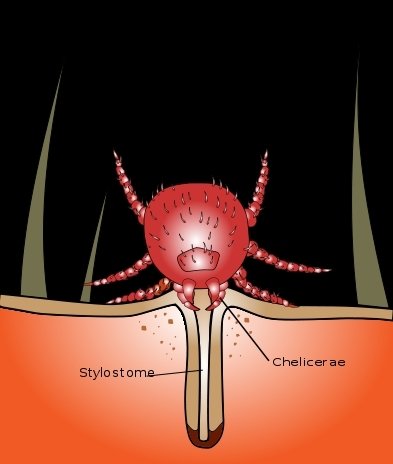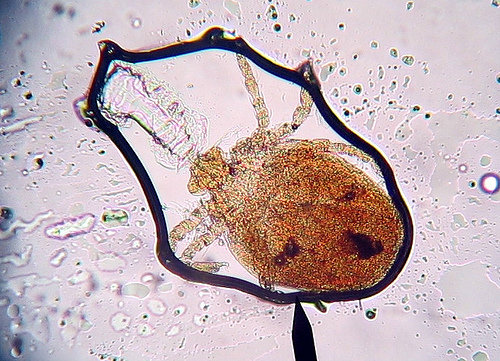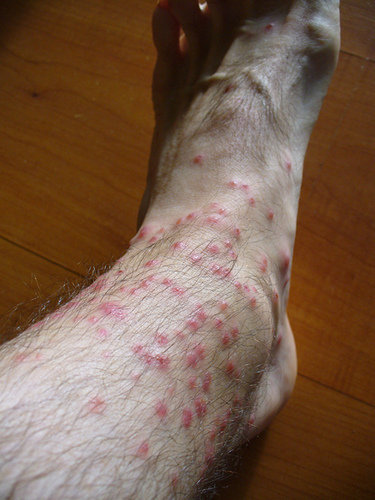





If you want to get someone really worked up, just mention a common summertime pest like chiggers, and listen to the results! You'll undoubtedly be regaled with all kinds of "facts" about chiggers, and remedies for their oh-so-uncomfortable bites. Let's take a look at some of the common misperceptions about chiggers, and set the facts straight!
Generally, the first thing someone will erroneously tell you about chiggers is that they burrow under your skin, and must be smothered to stop the intense itching and inflammation at the site of the bite. The very idea gives me the shudders. There are, indeed, insects that burrow under the skin, but fortunately, chiggers are not one of them. Rather, chiggers find an area where the skin is particularly thin and tender, such as your armpit, the backs of your knees, the crotch or groin area, and follow a hair follicle down to the skin and insert their piercing mouthparts, or chelicerae, into the pores of the skin. They attach to their host for up to three days. Rather than sucking blood, like a tick, they inject a digestive enzyme that literally liquifies your skin cells and lymph, so they can suck them up.
Rather than sucking blood, like a tick, they inject a digestive enzyme that literally liquifies your skin cells and lymph, so they can suck them up.
It is this fluid, injected into the skin, that causes the insanely itchy reaction in most humans. It has a two-fold effect, initially liquifying the cells, and then secondarily hardening them to form a straw-like feeding tube (stylostome) through which they can continue to feed. It is this hardened stylostome, which may appear as a red dot in the center of the bite, that likely led to the belief that the chigger itself was still present. Scratching off the top of the hardened stylostome may release some fluid from the bite, and leave it open to infection.
Chiggers are actually the larval form of a common insect in the mite family, Trombiculidae. There are four stages of the life cycle of the mite: egg, larva, nymph, and mite. It is the larval stage that causes such misery to animals and humans alike. The females lay their eggs in sheltered areas, often with longer grass or undergrowth that is infrequently disturbed. They hatch into the pre-larval form, which eventually transforms into the mobile six-legged larval eating machine that I so dread. Chiggers are opportunists, and will happily feed on a variety of hosts, including small mammals, birds, reptiles, amphibians, and given the opportunity, US! They lurk at ground-level or climb up leafy vegetation until an unsuspecting animal ventures near, at which point they will hop aboard and begin searching for a place to attach.
Unlike mosquitos, with their needle-like probes, the mouth parts (chelicerae) of chiggers are actually fairly weak. The chigger has to find a tender area to attach, and often needs something against which to push its legs in order to force its mouthparts into the skin. Hence their proclivity for the edges of socks, the elastic bands of underwear, waistbands, and cuffs. The tight clothing gives them something to push against while they attach.
 Unlike ticks, chiggers don't embed very deeply, and are fairly easy to remove. Even a brisk shower is enough to dislodge them, which is why showering immediately after time spent outdoors in undergrowth or long grass can minimize their opportunity to inject you with their toxic digestive juices. They can easily be brushed off, as well, though they are so tiny that they are rarely seen with the naked eye. A chigger measures only about 0.4 mm (1/60th of an inch). [1]
Unlike ticks, chiggers don't embed very deeply, and are fairly easy to remove. Even a brisk shower is enough to dislodge them, which is why showering immediately after time spent outdoors in undergrowth or long grass can minimize their opportunity to inject you with their toxic digestive juices. They can easily be brushed off, as well, though they are so tiny that they are rarely seen with the naked eye. A chigger measures only about 0.4 mm (1/60th of an inch). [1]
Quick removal can minimize the potential for future bites, but does little to alleviate the infuriating itching from the existing bite sites. The person who was bitten may start to feel the irritating itch 3 to 4 hours after the initial bite, but the worst of the itching begins as late as 24 to 48 hours after the bite has occurred. By then, the human immune system response to the bite has caused such swelling that the chigger is unable to continue to feed. Our allergic reactions are much more severe than that of most other animals. The resulting swelling means that most chiggers attempting to feed on humans are unsuccessful, and die without completing their meal. [2]
Once a larval chigger has completed a meal, they drop from their host, and proceed through the nymph stage, and then on to the adult stage, now with eight legs rather than its larval six legs. Neither of these pose any threat to humans, other than their potential to lay eggs and continue the cycle. A female mite will lay all of her eggs in one spot, preferring areas with high levels of vegetation.
Despite the proliferation of home remedies for chigger bites, there is no quick or sure path to relief. The most popular folk remedy suggests painting nail polish on chigger bites, in order to smother the bug that they believe to be embedded beneath the skin. I confess I tried it as a teenager, despite the lack of clear nail polish in the house, and spent days daubed with dark red crusty spots. It did little to relieve the itching, though it did serve as a visual reminder not to scratch. While it may offer some small measure of relief, simply by excluding air from the wheal, the chigger itself is long-gone, and nail polish will do little to help the inflammation. I will warn you that trying to remove the nail polish with nail polish remover, especially if you have been itching and have open sores, is agonizing!
Instead, experts recommend using one of the following treatments as soon as symptoms appear. The sooner you begin treatment, the shorter the duration of your suffering! There are a variety of recommended treatments, including:
One of the keys to treatment is to avoid secondary infections from scratching the bites. This can prolong the agony, and even cause ongoing skin issues that may require a trip to the doctor.
If you have been in an area prone to chiggers, you should wash your clothing thoroughly in the hottest water safe for the fiber content of the clothing, to kill any chiggers that may have climbed onto your clothing but not yet attached. Otherwise, they can linger in the clothing and drop off inside your house, or attach the next time you wear those items.
 To avoid the misery of chigger bites, the best plan is to avoid getting bitten in the first place. Insect repellents are effective deterrents, whether you choose a product containing DEET, or prefer to use pyrethrum, derived from extracts of a plant in the chrysanthemum family, which can be applied to clothing. There are even garments with pyrethrum incorporated into the fibers. If using a spray repellent, be sure to apply it especially to ankles, legs, waists, and sleeve areas, where the chiggers are most likely to attempt to attach. Wear protective clothing, such as long pants tucked into socks, and tightly woven fabrics to prevent them from gaining access to your skin. Avoid sitting or reclining directly on the ground, as that gives the little buggers even more opportunity to attach themselves to your tender parts.
To avoid the misery of chigger bites, the best plan is to avoid getting bitten in the first place. Insect repellents are effective deterrents, whether you choose a product containing DEET, or prefer to use pyrethrum, derived from extracts of a plant in the chrysanthemum family, which can be applied to clothing. There are even garments with pyrethrum incorporated into the fibers. If using a spray repellent, be sure to apply it especially to ankles, legs, waists, and sleeve areas, where the chiggers are most likely to attempt to attach. Wear protective clothing, such as long pants tucked into socks, and tightly woven fabrics to prevent them from gaining access to your skin. Avoid sitting or reclining directly on the ground, as that gives the little buggers even more opportunity to attach themselves to your tender parts.
Chiggers frequent areas of heavy vegetation, and seem to especially proliferate in areas with high bird, rodent, or reptile populations.
To control chiggers in your lawn, mow frequently, and minimize watering the turf. Chiggers thrive in warm, moist environments. Remove areas with shrubbery and heavy weeds, to minimize the cover that they prefer as egg-laying sites. There are chemical treatments for known infestations, including synthetic pyrethroids or carbamates. Apply these chemicals as directed on the label, and avoid getting insecticides into ponds and streams. [3]
A bulletin from the University of Kentucky College of Agriculture recommends this, for treatment of known hot-spots of chigger activity:
"Products containing bifenthrin (Ortho Home Defense MAX), carbaryl (Sevin), cyhalothrin (Spectracide Bug Stop Indoor + Outdoor Insecticide), and permethrin (various brands) can be effective. A single application during late-April or May is often all that is required, although in severe infestations, treatment may need to be repeated in June. The ground and vegetation up to a height of about three feet should be thoroughly wetted with the insecticide and applied according to label instructions. Children and pets should be kept off treated areas until the vegetation is completely dry." [4]
I have no personal experience with any of these chemicals. I attempt to avoid chemicals in my lawn and garden, and am especially cautious about using any pesticides that could potentially cause any harm to the thriving insect population in my yard. I plant areas of the garden specifically with the goal of attracting bees and butterflies, so the thought of applying insecticides to an entire area of my garden is foreign to me. I would only recommend this under extreme circumstances, and only on a very limited area with a known intense infestation. To determine the exact location of chigger hotspots, place 6 inch square pieces of black paper standing on edge in the grass or vegetation. Within a few minutes, any chiggers present will climb to the highest available point, the top edge of the paper, where they will be barely visible as tiny orange or red moving dust. Since the females lay their entire clutch of eggs together, there may be a concentration in one specific area, and none in an identical area immediately adjacent to it. Treat only the heavily infested areas.
If there is any bright side to the misery of chigger bites (and anyone who has suffered from them will tell you, it is nigh impossible to see a bright side when you are maniacally scratching in the middle of the night), it is only that unlike ticks and mosquitos, chiggers are not known to carry or transmit any diseases. You will be intensely miserable for up to two weeks, depending on how promptly you began treatment, but you will not suffer any serious or long-term effects.
References:
[1] http://en.wikipedia.org/wiki/TrombiculidaeImage
[2] http://edis.ifas.ufl.edu/ig085
[3] http://edis.ifas.ufl.edu/ig085
[4] http://www.ca.uky.edu/entomology/entfacts/ef630.asp
Photo Credits:
Macro close-up of chigger on leaf, thumbnail at beginning of article: Flickr Creative Commons, courtesy of Grant and Caroline's Pix (Some Rights Reserved)
Graphic of Chigger feeding: Wikimedia Commons, in the Public Domain
Image of Chigger mounted on slide: Flickr Creative Commons, courtesy of Cabezalana (Some Rights Reserved)
Picture of Chigger bites: Flickr Creative Commons, courtesy of scott.zona (Some Rights Reserved)
Copyright © www.100flowers.win Botanic Garden All Rights Reserved